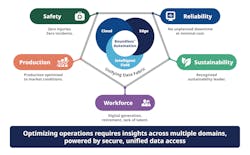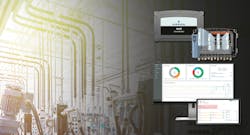How data mobility enables sustainability in pharma
For the last few decades, the primary concerns of pharma companies have been to develop treatments and to get them into the hands of patients safely and quickly, but a new concern has recently emerged. Public and regulatory pressure have increased for all manufacturers — life science companies included — to improve the sustainability of their operations. Consequently, organizations now need to manage not only safety and quality but also waste, energy, water usage and emissions.
Improving sustainability of pharma manufacturing operations can be complex. On one hand, there are numerous opportunities to implement sustainability improvements, ranging from site-specific changes to enterprise-wide initiatives. On the other hand, the expansive range of potential improvements can make it difficult for an organization to determine where to start. Effective sustainability initiatives require resources, such as time, money, knowledge, personnel and more. Therefore, if an organization is to invest these resources, it must do so in the most efficient and impactful manner possible.
Fortunately, companies do not have to be large, well-staffed or deeply knowledgeable about net-zero initiatives to make significant improvements in their sustainability posture. Today’s forward-thinking organizations are finding success by following two key strategies. First, they are embracing a boundless automation vision for their data, breaking down silos to enhance the visibility from the intelligent field, through the edge and across the enterprise. Second, they are implementing seamlessly integrated technologies designed for out-of-the-box interoperability. This approach ensures they can find suitable solutions regardless of the project scope and then easily scale successful initiatives as organizational needs evolve.
Insight across the intelligent field
Not every sustainability project needs to be an enterprise-wide 'net zero by 2030' initiative. In fact, many, if not most, organizations want to improve their sustainability, but are not ready for such sweeping change — nor, in most cases, do they need it. Many organizations have assets in the field that do not run as efficiently as they could. Those poorly performing assets, such as motors and pumps, can waste a lot of energy. Improving the visibility of underperforming or poorly performing assets is typically the easiest place to start making sustainability gains.
Improving visibility in the field starts with adding intelligent sensors to assets. Wireless transmitters are a fast, easy and cost-effective way to gain visibility into asset health to ensure they are not wasting energy or water, or leaking chemicals or greenhouse gases into the environment.
For one global biopharmaceutical company, starting small and proving success was key to developing a long-term sustainability program. The company focused on a single problem asset —steam traps — at a single facility to begin reducing their energy usage. They knew that they were wasting energy through poorly performing steam traps, many of which were in inaccessible or confined areas, resulting in them not getting sufficient attention. The reliability team determined that a more predictive maintenance strategy could help personnel automatically gather the data needed for better visibility, leading to improved performance and sustainability.
The team implemented wireless acoustic transmitters on the steam traps across the facility. However, even though the project was focused on a single type of asset, the team knew they wanted to plan for the future. Following a boundless automation vision, the team also implemented data analytics software that seamlessly integrated with their wireless transmitters. Because they were designed for interoperability out of the box, the transmitters and analytics software connected with no complex engineering, making it easy for the team’s analysts to track and trend performance of the steam traps from the very first moments of operation.
The maintenance team estimates that the steam trap project saves the company $34,000 per year by promptly addressing steam trap issues. Moreover, the company eliminated 230 metric tons of carbon dioxide emissions per year from this improvement. Upon seeing those results, the company decided to quickly scale up the project, with plans for three other national installations and one international implementation over the next few years.
Fortunately, the boundless automation strategy the team followed makes it easy for the company to roll out identical sensors in other locations, while still connecting them to the analytics software at the corporate office, all with no complex configuration required.
Driving data to the edge
Many pharma companies do not have a deep bench of trained analysts at each site to pore over asset data and trends to see where they can adjust to improve sustainability. These organizations need fast access to data to help them make decisions right where they are, while still maintaining the potential to send that data to a higher level for deeper analysis when necessary. Modern edge analytics devices are the perfect solution to close that gap.
Wireless edge analytics devices collect data from a wide range of assets, and then apply embedded analytics right at the source to immediately alert personnel to problems and provide recommendations for remediation. The best solutions use specialized analytics technologies to easily identify the most common issues in assets, helping personnel of any experience level quickly isolate and solve problems.
One North American biopharmaceutical company set ambitious sustainability goals of a 25% energy reduction by 2025. A core step for accomplishing those goals was to more efficiently use three redundant chillers that supported multiple buildings dedicated to research and development and commercial-grade retrovirus production. The reliability team knew they needed data to effectively monitor and maintain peak performance on the chillers 24x7. To gather the data, they installed edge analytics devices on each chiller.
The edge analytics devices provide both vibration and process data, as well as built-in analytics to help the team identify vibration and lubrication issues well before the machines fail. Upon installing the edge analytics devices, the team quickly discovered that one of the three chillers operated at much higher amplitudes than the other two because of plugging. Using the data gathered at the edge, the team was able to quickly make the appropriate repairs on the problem chiller and bring it back to peak operation.
Because the organization selected edge analytics devices designed as part of a seamlessly connected automation ecosystem, those devices will interconnect quickly and easily with future control and reliability solutions the company installs. The data that was freed from the device to move to the edge can further move up to the cloud, where it will be accessible and usable by cross-functional teams at the enterprise level when the organization chooses to scale the solution.
Expanding across the enterprise
Whether an organization tackles sustainability all at once with a massive, top-down effort, or chooses to scale up point solutions to capture further insight and more evasive gains, eventually most will want to move their data into the cloud for access at the enterprise level. Doing so is far easier if the company has adopted a boundless automation strategy for data mobility across all its automation solutions. As the number of devices and systems that must be brought into the fold increases, so too does the complexity of connecting all those elements without creating a complex web of custom-engineered interfaces. Solutions designed with a boundless automation vision are built on open standards and seamless connectivity, so they interconnect natively with little to no engineering effort.
For one global pharma innovator, seamless connectivity and movement of data across the enterprise was critical. The company’s annual energy bill totaled millions of dollars, and it needed to be reduced both to improve business expectations and to meet the company’s new sustainability initiative. The sustainability team knew that a big part of the problem was the many discrete elements of its operations. With over 20 different systems and approximately 80,000 tags in the energy system alone, critical data was siloed in many different locations.
Successfully managing energy use means bringing information technology (IT) and operational technology (OT) together. This is a significant challenge with the many disparate systems used in utilities — programmable logic controllers, distributed control systems, historians and more — which make it particularly difficult to manage and report energy use. Building a strong foundation of data management is key, because without it companies spend more time chasing, moving, adjusting and standardizing data than they do analyzing it. The company knew that achieving its sustainability goals would require the project team to navigate the complex IT/OT convergence.
To circumvent this complexity, the company followed its boundless automation vision for seamless data mobility by implementing a centralized data management system to collect, process, contextualize and standardize all its disparate energy data for use in seamlessly connected systems across the enterprise. The data management system gives the company a control tower view of both the supply and demand sides of their energy use, letting them make better, quicker decisions.
The solution not only connects seamlessly with enterprise resource planning software in the cloud, but also with asset management, alarm management and other critical software packages natively to ensure the highest level of visibility. Moreover, the software provides built-in visualization capabilities for energy monitoring and process visualization to monitor pumps, motors and other assets to see how process changes impact the overall energy landscape.
The organization expects its seamlessly integrated solution to deliver 2%-4% savings through better energy monitoring and reporting, easier data collection and more efficient alert management and utility monitoring. Ultimately, the company anticipates $1 to $2.5 million in cost savings to result from their standardized data foundation. Moreover, the improved strategy will help democratize the company’s data, making it easier for any authorized person to collect the data they need for use across the enterprise, while building a better foundation to streamline future projects
The right start, regardless of scope
Regardless of an organization’s size, many solutions exist to improve sustainability across the plant, site, or even the enterprise. As project teams begin evaluating how they will tackle their sustainability initiatives, it is critical to consider lifecycle value. If new systems add unwieldy complexity, they are unlikely to bring the gains that will deliver substantial improvement. Instead, focusing on solutions designed from the ground up to connect seamlessly will empower teams to start their sustainability journey at any level — from point solutions to enterprise-wide initiatives — while ensuring the ability to scale as necessary without added complexity.
Today’s most experienced automation providers can deliver that interoperability, with technology and software at every level designed to provide a seamless, intuitive experience. More sustainable operations will soon be a requirement for competitive advantage. Fortunately, the technologies exist today to capture it.
About the Author
Kristel Biehler
Vice President, Life Sciences, Emerson
Kristel Biehler is vice president of life sciences for Emerson’s process systems and solutions business where she leads the day-to-day business activities in sales, operations and technology that serve the life science industries. In her previous role at Emerson, she was the automation solutions vice president of sales for the western United States where she led teams that helped customers identify, architect and implement automation and digital strategies across a wide range of industries. Biehler started her career with Emerson in 1998. She holds a bachelor’s degree in mechanical engineering from the University of Utah. Prior to Emerson, she worked for Sorex Medical as an automation engineer.



